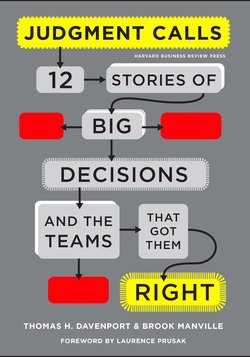Читать книгу Judgment Calls - Thomas H. Davenport - Страница 24
На сайте Литреса книга снята с продажи.
The House That Wouldn't Sell
ОглавлениеDespite the success of the project overall, one of WGB's spec houses in Brookmeadow Village sat unsold for much longer than the usual period. Priced at about $550,000, it was a substantial investment to carry for a family firm. WGB had tried something new with this particular home, but given what Burrill knew of changing demographics and customer preferences, it seemed like a safe bet. But if so, why wasn't it selling?
A nonselling house is an occasional but important problem for a small business like WGB. The way the company tackled the challenge reflects perhaps the most core element of great organizational judgment—pursuing a decision through an iterative process of problem solving. But the way it did that also reflects the special culture and leadership style of founder Greg Burrill.
Burrill's sales staff heard regularly from empty nesters and couples with older children that they enjoyed the community feel of a suburban neighborhood, but had different needs than young families. The wish for a master bedroom on the first floor came up repeatedly. Besides anticipating the day when they would not want to climb stairs so frequently, many customers thought the aging of the baby boom generation would give such houses high resale value. So WGB designed this house—called the Oxford—with a first floor master suite. It also had three other bedrooms upstairs, and a relatively small backyard—again, for baby boomers who don't want to spend all their time cutting grass—that looked out over forested land.
And indeed, interest in the house was high. But despite a significant amount of traffic through it, after six months it hadn't sold. At that point, Burrill worked with his sales office to figure out alternative ways to market the house, and also reduced the price a bit. That brought even more traffic—but months later, still no sale. Clearly the location was not the issue, but was it the lot size, or the price, or something about the design?
Burrill thought systematically about what he could change in the house. The lot size was fixed. He'd already lowered the price a bit, and lowering it further might reduce perceived values of all the other houses and lots in Brookmeadow Village. He leaned toward the design as the problem. Two other houses in the Grafton area with similar designs, built by other local builders, weren't selling either. Yet changing the design would be difficult, so he needed more information.
